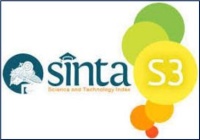Pengembangan E-Module Keanekaragaman Hayati Bermuatan Potensi Lokal Sumba Berbasis Inkuiri Terbimbing dengan Pendekatan (JAS) untuk Meningkatkan Literasi Lingkungan Siswa SMA
Abstract
Keywords
Full Text:
PDFReferences
Aristiani, R. (2016). Meningkatkan percaya diri siswa melalui layanan informasi berbantuan audiovisual. Jurnal konseling GUSJIGANG, 2(2). https://doi.org/10.24176/jkg.v2i2.717
Ayunda, A. D., Hasanah, H., & Ariyanti, N. A. (2024). Development of a Flipped Classroom-Based E-Module to Improve Problem-Solving Abilities and Learning Independence of High School Students. Journal of Biological Education Indonesia (Jurnal Pendidikan Biologi Indonesia), 10(2), 453-466.
Faizah, H., & Kamal, R. (2024). Belajar dan Pembelajaran. Jurnal Basicedu, 8(1), 466-476. https://doi.org/10.31004/basicedu.v8i1.6735
Fitri, R. (2024). Pengembangan Media Pembelajaran E-Modul Pada Materi Keanekaragaman Hayati. Jurnal Biogenerasi, 10(1), 384-389. https://doi.org/10.30605/biogenerasi.v10i1.4795
Liana, T., Sarong, A., & Sofyan, A. (2024). Development of Android-Based E-Modules in Biology Learning on Water Environmental Pollution to Enhance Science Literacy. Jurnal Penelitian Pendidikan IPA, 10(9), 644-654. 10.29303/jppipa.v10i9.8097
Maknun, J., Barliana, M. S., & Cahyani, D. (2016). The level of environmental literacy toward vocational high school students in West Java Province. INVOTEC, 12(2). https://doi.org/10.17509/invotec.v12i2.6205
Meilinda, H., Prayitno, B. A., & Karyanto, P. (2017). Student's environmental literacy profile of adiwiyata green school in Surakarta, Indonesia. Journal of Education and Learning (EduLearn), 11(3), 299-306. https://doi.org/10.11591/edulearn.v11i3.6433
Putra, S. H. J. (2021). Pendekatan Jelajah Alam Sekitar (JAS): Dampaknya terhadap Aktivitas dan Hasil Belajar Kognitif Siswa SMP. Journal of Natural Science and Integration, 4(2), 204. https://doi.org/10.24014/jnsi.v4i2.10030
Putra, E. P., Yanti, F. A., & Walid, A. (2023). Cultivating Scientific Literacy: Developing A Biodiversity E-Module Based on Socioscientific Issues and Local Potential. Edukasi Islami: Jurnal Pendidikan Islam, 12(001).
Parwati, N. N., Suryawan, I. P. P., & Apsari, R. A. (2019). Belajar dan Pembelajaran. RajaGrafindo Persada.
Rosdewi, M., Sada, M., & Fitriah. (2023). Inventory and Identification of Natural Dyes of Ikat Woven Fabrics at Sanggar Bliran Sina Watublapi. 3(1), 6–19. https://doi.org/10.56495/jrip.v3i1.341
Saragih, P. P., & Tanjung, I. F. (2023). Development of STEM-Based Environmental Change Module to Enhance Environmental Literacy. Biosfer: Jurnal Tadris Biologi, 14(1), 89-98. http://dx.doi.org/10.24042/biosfer.v14i1.17884
Seran, W., & Hana, Y. W. (2018). Identifikasi Jenis Tanaman Pewarna Tenun Ikat di Desa Kaliuda Kecamatan Pahunga Lodu Kabupaten Sumba Timur. Agrikan: Jurnal Agribisnis Perikanan, 11(2), 1.
https://doi.org/10.29239/j.agrikan.11.2.1-8
Setiawan, H., & Rahayu, E. S. (2024). Development of E-Modules Based on Problem Based Learning Assisted by Flipbook on Environmental Change Material in High School to Improve Problem Solving Ability. Journal of Biology Education, 13(1), 29-35.
https://journal.unnes.ac.id/journals/ujbe/article/view/4091
Suarsana, I. M., & Mahayukti, G. A. (2013). Pengembangan E-Modul Berorientasi Pemecahan Masalah Untuk Meningkatkan Keterampilan Berpikir Kritis Mahasiswa. 2(2), 265–275. https://doi.org/10.23887/jpi-undiksha.v2i2.2171
Sulastri, M. R., Ramdani, A., & Mertha, I. G. (2024). Efektivitas Pendekatan Jelajah Alam Sekitar Terhadap Hasil Belajar Siswa Pada Materi Klasifikasi Makhluk Hidup. Journal of Classroom Action Research, 6(4), 776-781. 10.29303/jcar.v6i4.9510
Sunarto, S. (2023). Environmental Literacy and Care Behavior Through Adiwiyata Program at Elementary School. Al-Ishlah: Jurnal Pendidikan, 15(3), 3040-3050. https://doi.org/10.35445/alishlah.v15i3.3887
Wardhani, Y. S., Al-Muhdhar, M. H. I., Suhadi, S., & Ahmad, R. (2022). Pengembangan E-Module Adiwiyata Berbasis Reading Mind Mapping CIRC untuk SMA Kelas X (Doctoral dissertation, State University of Malang). 10.17977/jptpp.v7i4.15216
Wulandari, M. R., & Nuhumara, Y. T. I. (2021). Eksplorasi Tenun Ikat Sumba Timur Ditinjau Dari Etnomatematika. Satya Widya, 36(2), 105–115. https://doi.org/10.24246/j.sw.2020.v36.i2.p105-115
Wulandari, W. T., Mayub, A., & Johan, H. (2023). Pengembangan E-Modul Berbasis Analisis Parameter Fisis Air Sungai untuk Meningkatkan Literasi Lingkungan Peserta Didik. JIPVA (Jurnal Pendidikan IPA Veteran), 6(2), 103-115. https://doi.org/10.31331/jipva.v6i2.2290.
DOI: https://doi.org/10.33394/bioscientist.v12i2.13713
Refbacks
- There are currently no refbacks.

This work is licensed under a Creative Commons Attribution-ShareAlike 4.0 International License.

Bioscientist : Jurnal Ilmiah Biologi is licensed under a Creative Commons Attribution-ShareAlike 4.0 International License
Editorial Address: Pemuda Street No. 59A, Catur Building Floor I, Mataram City, West Nusa Tenggara Province, Indonesia











